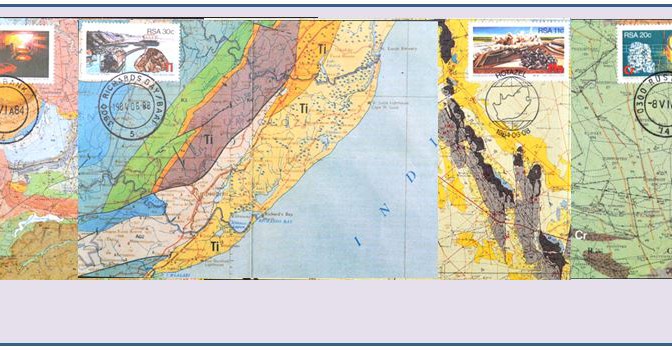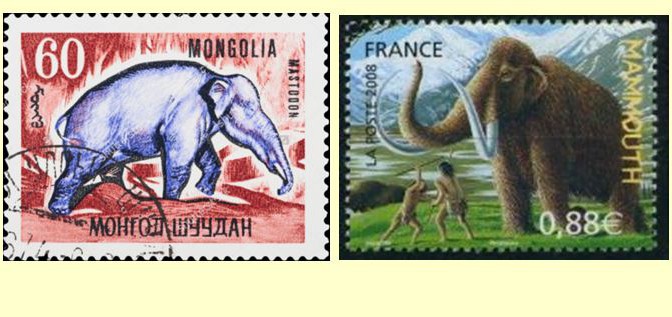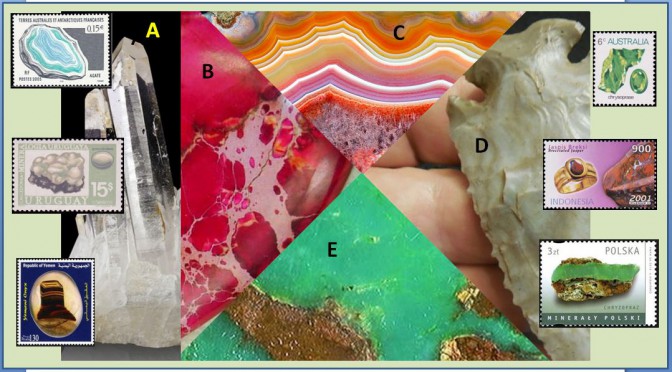
A Maximum Card (often referred to as a maxicard) is a philatelic postcard with a postage stamp placed on the picture side of the card. The stamp and card match or in some way relate to each other. Maxicards are officially released by many of the world’s postal services, but they are also generated personally by individuals combining a stamp issue with a simple souvenir postcard. In most cases, the cancellation is also related to the image on the front of the card and the stamp.
As a collector of minerals, mining and geology on stamps South Africa’s 1984 four-stamp set commemorating some of the country’s strategic resources was a fine add to my collection. It was not until a couple of years ago, however, that I learned that the officially released Maximum Cards S10-S13 for these stamps featured geologic maps. Not only would this satisfy another of my topical interests (maps on stamps), but as a retired geologist I found the inclusion of geologic maps on the “Maxicards” most interesting. Thanks to a tip provided by a fellow member of The CartoPhilatelic Society on the club’s shared discussion site, I was able to purchase a complete set via an online source.
Now it seemed only fitting that I research the stamps and maps a bit. This note will be constructed to accommodate both Philagems and The New CartoPhilatelist, newsletter of the Maps on Stamps Study Units, as the cards are equally collectible for members of both ATA study units.
Continue reading South African Mineral Maxicards →

Written for the March 2016 Wayne County Gem and Mineral Club newsletter
The mineral beryl is hard and can sparkle with exceptional clarity and wondrous color when free of inclusions and defects, clearly justifying its lofty gemstone status. In fact, not just one gemstone, but several depending on the color imparted by trace amounts of iron, chromium, manganese and other transition elements substituting into the crystal lattice. Aquamarine, emerald, morganite, and heliodor are all gemstones of the mineral beryl. But it is sky blue variety that has our special attention this month as aquamarine is the March birthstone.
Continue reading Aquamarine – March birthstone →

co-authored with Stephen Mayer for the March 2016 Wayne County Gem and Mineral Club newsletter
As geologists and amateur fossil and rock hounds, many of us focus on the Proterozoic minerals of the Adirondacks and/or the Paleozoic fossils of western and central New York State. However, two very important and much overlooked prehistoric animals roamed New York State approximately 10,000 years ago. The Woolly Mammoth and the American Mastodon were prominent residents in our own backyards.
Continue reading Titans of the Pleistocene →

Published in the February issue of WCGMC News
Quartz is simple. Right? Just a silicon (Si) atom nestled in the center of a tetrahedral form surrounded by four oxygen atoms. Build them together, let the silica-centered tetrahedral motifs share oxygen atoms and bingo we have SiO2. Quartz crystals grow from this. They grow into beautiful clear, milky or smoky trigonal crystals with six-sided prisms terminating in six-sided pyramids, simple as a childhood erector set or a Lincoln Log cabin (with that distinctive green roof). Herkimer diamonds are our favorites, but amethyst and citrine colors are nice too.
OK, but now we are told that quartz which grows rapidly or under “special” conditions can be cryptocrystalline, a condition that exists when the individual quartz crystals are too small to see even with an optical microscope. And this apparently changes everything. No longer are we collectors satisfied to apply the common mineral name, albeit with a few modifiers for color (amethyst, citrine, rose quartz).
Continue reading The Many Names of Quartz →
Retired, collecting minerals and stamps, growing flowers and vegetables, and when the spirit moves, toying with technology



